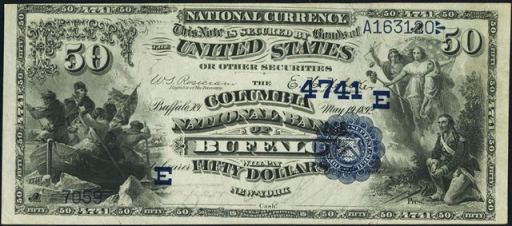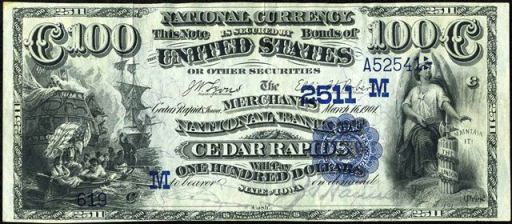The Home National Bank Of Brockton
The Home National Bank Of Brockton in Massachusetts printed $1,478,000 dollars worth of national currency. Over $1,000,000 face value is a lot of money. However, some types and denominations of currency from this bank could still be rare. This national bank opened in 1874 and stopped printing money in 1935, which equals a 62 year printing period. That is considering a long operation period for a national bank. During its life, The Home National Bank Of Brockton issued 14 different types and denominations of national currency. We have examples of the types listed below. Your bank note should look similar. Just the bank name will be different. For the record, The Home National Bank Of Brockton was located in Plymouth County. It was assigned charter number 2152.
We buy all national currency. Please call or email us for a quote. Sales@AntiqueMoney.com
The Home National Bank Of Brockton in Massachusetts issued 8,500 sheets of $5 original series national bank notes. Just because a print range is between 5,000 and 10,000 doesn’t mean that individual notes will be easy to buy. That number isn’t really high or low. Some notes are extremely rare and some could be from a hoard. Values are determined based on condition and the number of known survivors. Each five dollar original series bank note has a spiked red seal. That is pretty much the only design difference between it and later issues. These are really beautiful notes. One neat thing about these is that the back of each note has a vignette of the corresponding state seal. Some of the state seals are very imaginative. Collecting by state seal was very popular early on in the hobby. Today most collectors are more concerned about bank of issue and condition. Serial number one bank notes are also extremely popular.
Original Series $5 National Bank Note
The Home National Bank Of Brockton printed 650 sheets of $5 series of 1875 national bank notes. It is rare to see a sheet output of under 1,000 like this. However, it did happen for some very scarce issuers. Series of 1875 $5 bills are some of the most commonly encountered bank notes from the first charter series. Only the original series $1 bill is more available. Some banks exclusively issued five dollar bills. So if you want an example from one of those banks then you don’t have many options. These notes have a rounded red seal and red serial numbers. They also all have a red charter number.
Series of 1875 $5 National Bank Note
The Home National Bank Of Brockton also printed 8,933 sheets of $10 series of 1875 national bank notes. A print range between 5,000 and 10,000 is a pretty high number. But you have to remember we are talking about bank notes from the 1870s and 1880s. Even banks with high issue numbers could be rare today. The two vignettes seen on 1875 $10 bank notes are “Franklin and Electricity” and “America Seizing Lightning”. These notes occasionally confuse novices because the year 1752 is printed on them. That is when Benjamin Franklin discovered electricity. It has nothing to do with when these bank notes were issued. The back of each $10 bill has “DeSoto Discovering the Mississippi.”
Series of 1875 $10 National Bank Note
The Home National Bank Of Brockton also printed 8,933 sheets of $20 series of 1875 national bank notes. The exact number of series of 1875 $20 national bank notes printed by this bank is good to know. Don’t expect a high number to lower the value or a small number to increase the value. These notes are scarce enough on their own that the stats don’t really matter. Twenty dollars was a lot of money between 1875 and 1901, which is the time period in which these were printed. These just weren’t saved in high numbers.
Series of 1875 $20 National Bank Note
The Home National Bank Of Brockton also printed 3,300 sheets of $10 1882 brown back national bank notes. That it is not an exceptionally low number of sheets. However, you have to remember that we are talking about bank notes printed before 1902. Even a large print number could have a very low survival rate. There were three $10 bills printed on a single sheet of 1882 brown backs. The design of the bill is similar to all earlier ten dollar national bank notes. The nickname comes from the fact that these bills have a brown seal and brown overprint. Despite saying series of 1882, these were actually printed by some banks up until 1908. The date you see in cursive relates to when the bank first started issuing brown back notes.
Series of 1882 $10 Brown Back
The Home National Bank Of Brockton also printed 3,300 sheets of $20 1882 brown back national bank notes. As you can see, the sheet output is the same for $20 brown backs as it is for $10 brown backs. There was only one $20 brown back printed on a sheet. So the sheet output also equals the total note output. One neat thing about all brown backs is that they each have a different back design based on which state issued them. The back left hand side of the note shows the state seal of which ever state the national bank was located in. Generally speaking, 1882 $20 brown backs are pretty difficult to locate. They typically were printed in small numbers and they don’t have a great survival rate.
Series of 1882 $20 Brown Back
The Home National Bank Of Brockton also printed 1,800 sheets of $50 1882 brown back national bank notes. Not many banks printed $50 1882 brown backs. Sheet outputs aren’t extremely important. However, it is good factual information to know. The most common 1882 $50 brown backs are worth about $5,000. However, some can be worth more than $10,000 based on condition, serial number, and bank of issue.
Series of 1882 $50 Brown Back
The Home National Bank Of Brockton also printed 1,800 sheets of $100 1882 brown back national bank notes. Just because this bank printed more than 1,000 one hundred dollar brown backs does not mean that they are all common. We are very interested in purchasing $100 1882 brown back national bank notes. We have paid more than $15,000 for some examples. Send us pictures of what you have and we will respond quickly with an appraisal and offer.
Series of 1882 $100 Brown Back
The Home National Bank Of Brockton also printed 868 sheets of $10 1882 blue seal national bank notes. 1882 blue seals are traditionally not the most popular national bank notes. However, when we are talking about such a low print number, these become much more desirable. All of these notes say series of 1882 but they were actually printed between 1908 and 1921. So they aren’t quite as old as the dates might suggest. There is also a date on these notes that is between 1888 and 1901. That date is written in cursive text and it represents when the bank was chartered or re-chartered. Some of the so called 1882 value back notes have a chance to be really rare. Most of the earlier notes that say 1882-1908 on the back are likely going to be relatively common. The designs are exactly the same on the front. Each has a blue seal and charter number.
1882 Blue Seal $10 National Bank Note
The Home National Bank Of Brockton also printed 868 sheets of $20 1882 blue seal national bank notes. That is the same number of sheets as the ten dollar denomination. You don’t have to multiply by three to get the exact number of notes issued though. There was only one twenty dollar bill per sheet. As with any national bank note, the exact value is still based on the condition, serial number, and bank of issue.
1882 Blue Seal $20 National Bank Note
The Home National Bank Of Brockton also printed 61 sheets of $50 1882 blue seal national bank notes. High denomination 1882 blue seals like this are not frequently encountered, regardless of the number of notes printed. There is a big difference between the two types of 1882 $50 blue seals. The variety that says “1882-1908” on the back is rare, but no where near as rare at the type that says “Fifty Dollars.” The second variety is extremely rare and only about a half dozen are known to exist. The first type should still be worth at least $4,000. The second type is a five figure rarity though.
1882 Blue Seal $50 National Bank Note
The Home National Bank Of Brockton also printed 61 sheets of $100 1882 blue seal national bank notes. The number of sheets printed doesn’t matter too much here. All 1882 $100 blue seals are rare. They were issued by a total of 256 total national banks in the country. The rare 1882 value backs were only printed by banks in Dayton, Ohio and New Orleans, Louisiana. The slightly more common date backs are much more plentiful but still rare in the scheme of things.
1882 Blue Seal $100 National Bank Note
The Home National Bank Of Brockton also printed 7,216 sheets of $10 1902 blue seal national bank notes. That is a fairly standard sheet output for a national bank issuing blue seals. You likely aren’t dealing with a super common or a super rare bank note. 1902 $10 blue seal bank notes all have a portrait of William McKinley on them. Values can range from as little as $40 up to over $10,000. There really is no trick to know what is rare and what is common by just doing an internet search. You really need to work with an expert (like us) in order to determine the value of your specific bank note. There are at least ten different factors than can make some 1902 $10 blue seals worth more than others. We know exactly what to look for and we would be happy to provide a free appraisal and our best offer.
1902 $10 Blue Seal National Bank Note
The Home National Bank Of Brockton also printed 7,216 sheets of $20 1902 blue seal national bank notes. The same rarity rules for 1902 $10 blue seals also apply to $20 blue seals. Just remember that $20 bills are by nature three times rarer (unfortunately they don’t command a premium over other denominations). Hugh McCulloch is pictured on the front of each bill. Contact us if you need pricing help.
1902 $20 Blue Seal National Bank Note



